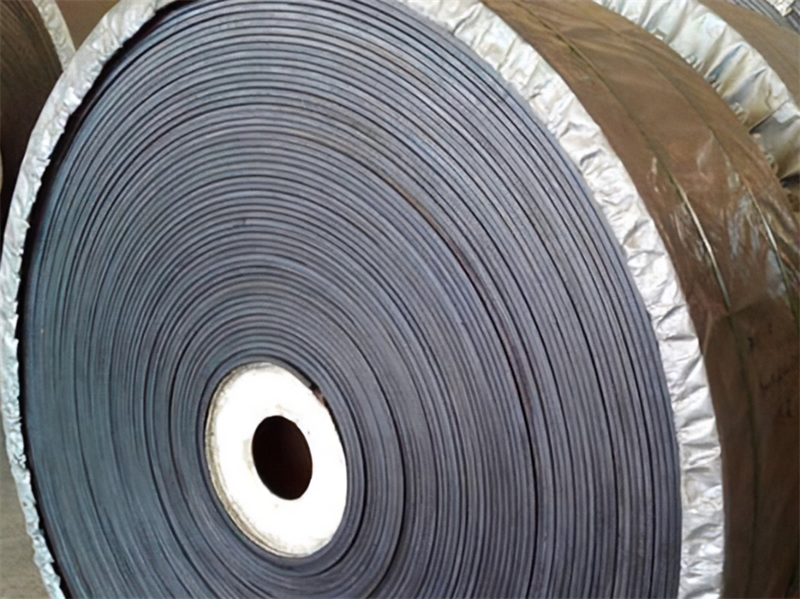
Injuries and causes
1. Local wear and tear (epidermal damage) Fabric core conveyor belts and steel wire core conveyor belts are very susceptible to such damage. The main reason is that the transfer place, the guide trough, the failed roller and other parts are easy to get stuck in the larger material block, once the conveyor belt is running, it will inevitably cause excessive wear of the conveyor belt. Rizhao Port coal loading and unloading system stacker, reclaimer and other cantilever belts have occurred conveyor belt local grinding to 5 layers of canvas and other parts of the covering glue is better, in the loading system a belt due to the low skirt of the guide trough directly stuck on the belt, resulting in the belt on both sides of the skirt all grinding out of the steel wire.
2. Local crushing (penetrating injury) Fabric core conveyor belts and steel wire core conveyor belts have this type of damage. When conveying materials in the conveyor belt, there are often larger stones and sharper material blocks mixed in it, and these material blocks are not enough to buffer at the transfer place, and they break through the conveyor belt with a large impact force to form a hole. If the material is mixed with sharp objects, such as iron crowbars, it is very easy to cut the conveyor belt, causing a large area of tearing on the conveyor belt.
3. Damage to the glued joint The adhesive part of the conveyor belt is formed by relapping and vulcanizing when the belt is installed. If the joint part is not treated well, it is easy to cause premature wear of the joint part, glue peeling and other phenomena. If not dealt with in time, the damage and deterioration of the joint part will be faster, and the belt breakage accident will easily occur.
4. Longitudinal crack of steel wire core conveyor belt Some steel wire core conveyor belts often have longitudinal penetrating scratches, up to tens of meters or even hundreds of meters, such damage is generally called longitudinal cracking. The reason for this is that the sharps are stuck in some places, such as the scraper cleaner, and the operator does not clean it up in time, which causes long-distance scratches and tears on the conveyor belt after the belt runs. Breakage repair During the use of conveyor belts, damage is inevitable, and there are many forms of damage, such as: edge delamination, ulceration, defects and cracking; Long-distance longitudinal tears, deep scratches, holes, large-scale abrasion, bulging or peeling of the covering, internal defects of joints, etc. Among them, longitudinal tear is the most urgent, edge damage is the most common, internal defects of the joint are unavoidable, and the service life after repair is the most concerning.

There are three main methods commonly used to repair conveyor belts
1. Hot repair method: Usually use special repairers, vulcanizers and hot vulcanized materials suitable for conveyor belts to repair the damaged parts of the conveyor belt with the same strength of "no trace". This kind of repair can completely eliminate the damage of the conveyor belt and restore it to its original state. It is suitable for more important, long-distance, high-speed operation, large-volume transportation systems. Of course, specialized equipment and professionals are required to complete this type of maintenance. It is the most reliable and ideal method for conveyor belt maintenance.
2. Cold repair method: Usually the cold adhesive and repair film and special tools for the conveyor belt must be used to repair the damaged parts of the conveyor belt by filling to achieve the purpose of continuous operation. Obviously, this kind of infill restoration is a stopgap measure.
Therefore, its main purpose is: when the conveyor belt is damaged, timely cold repair can be carried out to prevent the damage part of the conveyor belt from continuing to expand and extend, so as to effectively protect the core of the conveyor belt from damage, so as to wait and obtain the time and opportunity required for repair.
3. Mechanical repair method: Clips, nails, connecting plates and screws or metal cords and special appliances made of metal materials are usually used to fix or connect the damaged parts of the conveyor belt to achieve the purpose of maintaining operation. Even in many times and occasions today, this seemingly simple, rough, and even ugly method of dealing with it can play an emergency function and achieve twice the result with half the effort. To sum up: the most ideal and perfect repair of the conveyor belt must be strictly in accordance with the principle of "equal strength, same life", that is, the use of hot repair technology and technology can be realized. The real purpose of the application of other repair technologies is to obtain the right time and opportunity for repair. Therefore, cold repair and mechanical repair should never be used as a final treatment for belt damage. Only trying to be convenient and simple, pursuing low cost and short time, the result is very likely to be endless troubles. We hope that every conveyor belt system management and maintenance staff must have a clear understanding and thorough understanding of the basic concept of conveyor belt repair, and successfully and smoothly complete the gluing and maintenance of conveyor belts.